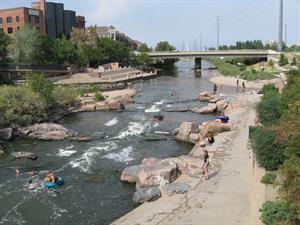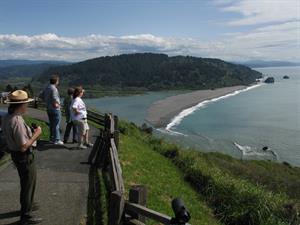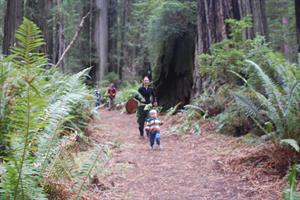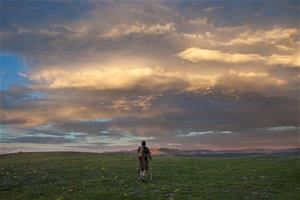Aside from our constitutional rights to life, liberty, and the pursuit of happiness, one of the greatest joys of being an American is our system of public lands. Of the 2.3 billion acres of land that comprise the United States, some 640 million acres (28 percent) are administered by the federal government for all Americans. These federal public lands are found in all 50 states, five U.S. territories, and the District of Columbia. Some have remained federal public lands since our country’s independence. Others have been sold off or gifted by U.S. presidents and Congresses to raise funds and to serve both public goals and private purposes, including homesteading, railroad construction, and mining.
We got started pretty early in conservation as a nation. Since the late 19th century, presidents and Congresses have debated and made decisions on how our public lands should be managed. Abraham Lincoln set aside Yosemite Valley in 1864 for conservation. Ulysses S. Grant signed a law in 1872 establishing Yellowstone as the world’s first national park. Theodore Roosevelt set aside millions of acres as forest reserves and numerous national wildlife refuges and monuments. Similar decisions resulted in allocating public lands to be managed for a variety of public purposes, including the National Park System (84 million acres), National Wildlife Refuge System (89 million acres), Bureau of Land Management public lands (247 million acres that include wilderness areas and national monuments), National Forest System (193 million acres), recreation areas operated by the Army Corps of Engineers (12 million acres), military lands (19 million acres), and lands managed by a few smaller agencies.
Fifty years ago, at the urging of conservation and outdoor recreation leaders, the president and Congress determined that it was necessary and appropriate public policy to add lands and waters to the public domain by establishing a source of federal funds to acquire and develop these areas for outdoor recreation and conservation purposes. The Land and Water Conservation Fund Act of 1965 was thus intended to complete the conservation estate of America.
The Land and Water Conservation Fund (LWCF) is financed today through royalty payments derived from leasing submerged lands on the Outer Continental Shelf for oil and natural gas drilling. The chief rationale is that as one finite public resource (oil and gas) is permanently depleted, a percentage of the money derived from selling off what we all own should be allocated to buying other lands for a permanent conservation legacy to be enjoyed by future generations.
Since 1965, Congress has appropriated a total of $10.2 billion for the so-called “federal side” of LWCF, allowing acquisition of 5 million acres of new federal lands and waters. In addition, Congress has allocated $4.2 billion to state assistance grants, which have funded some 41,000 projects in virtually every county in America. State grants, which are provided as 50-50 matching grants, have supported conservation of 3 million acres of land water and more than 29,000 state and local outdoor recreation facility projects.
How LWCF Was Intended to Work
 LWCF funding was initially derived from sales of surplus federal lands, recreation fees, and motorboat fuel taxes and was capped at $100 million per year. Congress amended the Land and Water Conservation Fund Act in 1977, and again in 1978, to incrementally increase LWCF to a cap of $900 million by adding revenue derived from oil and gas drilling receipts. As these receipts became more readily available (averaging $7 billion to $9 billion per year), the original revenue sources were transferred to other purposes.
LWCF funding was initially derived from sales of surplus federal lands, recreation fees, and motorboat fuel taxes and was capped at $100 million per year. Congress amended the Land and Water Conservation Fund Act in 1977, and again in 1978, to incrementally increase LWCF to a cap of $900 million by adding revenue derived from oil and gas drilling receipts. As these receipts became more readily available (averaging $7 billion to $9 billion per year), the original revenue sources were transferred to other purposes.
Today, $900 million is put into an LWCF account in the U.S. Treasury each year. The money is intended to protect federal public lands and waters (including voluntary conservation on private lands) and provide matching grants to states for state and local public outdoor recreation projects and facilities. Amendments to the LWCF Act in 1976 specified that “no less than 40 percent” of appropriations must be available for federal purposes.
The four participating federal agencies — the National Park Service, U.S. Fish and Wildlife Service, Bureau of Land Management, and U.S. Forest Service — prepare annual acquisition priorities and compete internally for departmental and White House Office of Management and Budget approval to be included in the president’s annual budget proposal to Congress. House and Senate Appropriations Committees then review the president’s requests, layer in their own priorities and additions or reductions, mark up the annual appropriations bill, and take it to the full House and Senate chambers for debate and vote and, ultimately, the president’s approval.
Funds for the state grants are appropriated in a lump sum and allocated to states by the National Park Service according to a formula in the 1965 Act. The formula provides that 40 percent of the appropriated lump sum be divided equally among the states and 60 percent be apportioned on the basis of need, with population size the primary factor in determining “need.” To qualify to receive LWCF funds, each state must prepare (and periodically update) a Statewide Comprehensive Outdoor Recreation Plan, which sets out priorities and how the state will allocate the funds between land and water acquisitions and outdoor recreation facility development.
Another LWCF state-side requirement, and the one with the greatest impact on long-term protection of recreation resources, is a provision that all property acquired or developed with LWCF assistance must be maintained perpetually for public outdoor recreation use. Any state- or locally proposed conversion out of public recreation of LWCF-acquired lands can only be done with approval of the Secretary of the Interior and only by providing equivalent-value lands for conservation and recreation to replace the lands acquired through LWCF funds.
With these safeguards in place, one might expect that Congress would fully support LWCF — particularly since tax dollars are not involved. However, in the congressional funding battle, conservation often gets the short straw.
How LWCF Actually Works (or Not)
 The chief weakness of the Land and Water Conservation Fund is that it is not a true “trust fund” or “mandatory appropriation.” Unlike the Highway Trust Fund, which relies on motor fuel taxes for its revenues and cannot be diverted to other purposes, LWCF is “authorized” for $900 million annually but not guaranteed to receive it.
The chief weakness of the Land and Water Conservation Fund is that it is not a true “trust fund” or “mandatory appropriation.” Unlike the Highway Trust Fund, which relies on motor fuel taxes for its revenues and cannot be diverted to other purposes, LWCF is “authorized” for $900 million annually but not guaranteed to receive it.
In fact, since 1965, Congress has diverted some $19 billion of authorized LWCF funds to other purposes — which means that instead of spending the now-$900 million maximum each year on LWCF projects, Congress left a significant portion of that money in the U.S. Treasury to be spent elsewhere. The only year LWCF had a full appropriation was in 1979. In the years since, the federal share has grown significantly — averaging more than 80 percent — and state grants have sometimes been zeroed out completely. As a consequence of this gross underfunding, states have identified $27 billion in unmet outdoor recreation needs.
Early in the George W. Bush Administration, there were repeated calls for “full funding of LWCF” from members of both parties in Congress and a broad cross-section of citizen organizations. In a misguided attempt to meet the “full-funding” test, rather than simply requesting $900 million in appropriations for LWCF authorized purposes, the administration and Congress inserted several programs into the LWCF funding stream that are not within the statutory purposes of the Fund, including endangered species and forest legacy grant programs.
This is not to say that grants for conserving endangered species habitat or restoring forest health are a bad thing. But congressional budgeting is a zero-sum game, and dollars spent on these programs are dollars taken away from state parks and outdoor recreation support — the purpose of the LWCF State Assistance Program.
Case for Re-Authorization
 The Land and Water Conservation Fund was created to permanently protect some of America’s land, water, and recreation resources. Yet as Congress diverted LWCF funds for other purposes over the past 50 years, real estate values and development costs increased exponentially. Dynamic population growth will continue, as will land and park development costs, especially in metropolitan areas where open space is at a premium. Public lands and outdoor recreation facilities are needed now more than ever — as is funding to help secure them.
The Land and Water Conservation Fund was created to permanently protect some of America’s land, water, and recreation resources. Yet as Congress diverted LWCF funds for other purposes over the past 50 years, real estate values and development costs increased exponentially. Dynamic population growth will continue, as will land and park development costs, especially in metropolitan areas where open space is at a premium. Public lands and outdoor recreation facilities are needed now more than ever — as is funding to help secure them.
Of course, the strongest argument for reauthorizing the Land and Water Conservation Fund is that it works. On the federal side, LWCF has been used to conserve some of the most iconic and well recognized sites in America, including Big Cypress National Preserve (Florida), Redwood National Park (California), New River Gorge National River (West Virginia), the Appalachian National Scenic Trail (14 states from Maine to Georgia), and Voyageurs National Park (Minnesota).
In addition to thousands of smaller recreation areas, grants from the state side of LWCF have helped to acquire and develop new parks of statewide or national significance, including:
- Allagash Wilderness Waterway, a 92-mile ribbon of lakes, ponds, rivers, and streams that wind through the heart of northern Maine
- Liberty State Park, located on a former transportation hub where the Central Railroad of New Jersey transported millions of newly-arrived immigrants to their new homes in the United States
- Willamette River Greenway, which protects fish and wildlife habitat, water quality, and scenic resources in Oregon’s most populated region and improves public access to the river
- Confluence Park, located on the South Platte River, which leveraged $1.2 million in LWCF grants to galvanize more than $2.5 billion in public and private funding to revitalize downtown Denver, Colorado
- Herman Brown Park, an oasis at the intersection of two of Houston’s busiest freeways, which offers tennis courts, playgrounds, and bike paths as well as an undisturbed area of bottomland hardwood forest with trails
- Illinois Beach State Park, a 6.5-mile stretch of Lake Michigan’s sandy shoreline in northern Illinois and the only remaining beach ridge shoreline left in the state
Locally, the Land and Water Conservation Fund has supported development of thousands of playgrounds, soccer fields, and baseball diamonds in communities across the country.
Will LWCF be available to support these types of outdoor recreation opportunities in the future?
Proposals for the Fund’s Future
 Ideas for the future of the Land and Water Conservation Fund are as varied as the projects the Fund supports.
Ideas for the future of the Land and Water Conservation Fund are as varied as the projects the Fund supports.
Quick Fix Best-Case Scenario: A simple solution for re-authorizing LWCF is a permanent appropriation of $900 million annually from a U.S. Treasury account, not subject to further appropriation, using royalties from leasing oil and gas on the Outer Continental Shelf (the current funding source). The Obama Administration proposed a legislative procedure to make LWCF a “permanent appropriation” of $900 million through a gradual transition using a combination of discretionary and permanent appropriations.
An even better scenario would be for Congress to increase the permanent funding level for LWCF to adjust for inflation over the past 50 years. If that were done, LWCF revenue would exceed $3.2 billion annually, which would provide a reliable stream of funding for outdoor recreation and conservation.
Quick Fix That’s Less Desirable: Other proponents would simply change the “sunset” date of the LWCF Act to 2065, thus authorizing the Fund as-is for another 50 years. That means House and Senate Appropriations Committees would still control allocations and could add/ delete specific projects within the annual total of the Fund. This “power” of the appropriators to allocate funding has thwarted previous attempts to make LWCF a permanent appropriation.
Misguided Focus on Maintenance: The most talked about proposal in Congress right now is one to allocate at least a portion of LWCF’s authorized $900 million to reducing the maintenance backlog on public lands. There is a multi-billion-dollar backlog of identified public land maintenance projects across all four federal public land agencies. However, this is an artificially construed conflict — land conservation and facility maintenance are not mutually exclusive, especially since LWCF has a dedicated non-tax revenue source and infrastructure is paid for through other revenues.
Maintenance projects are funded through the General Fund. If LWCF dollars are allocated to maintenance, Appropriations Committees in Congress would almost certainly reduce the amount appropriated for maintenance from the General Fund by a like amount, thus creating no net funding gain for maintenance. In addition, at least half of the identified maintenance backlog is roads and bridges — basic infrastructure projects that are paid for out of the Highway Trust Fund, not general appropriations. Unquestionably, America needs a solution to its severe infrastructure problem, not just on public lands.
Setting State and Local Allocations: For state and local assistance, the major proposal is to delete the “no less than 40 percent” requirement for the federal side of LWCF and insert a firm allocation of the $900 million — either in actual dollar amounts or as an explicit percentage — to the state grant program. More recently, city park advocates have weighed in with a strong “Mayors for Parks” campaign, arguing for breaking out an explicit city park grants programs allocation of federal-state-local funds (i.e., $300 million each at the federal, state, and local levels) in a re-authorized LWCF.
Limited Geographic Scope: Delving ever more deeply into the controversial weeds of LWCF, it has been suggested that some measure of settlement between the federal land acquisition advocates and opponents could be achieved by inserting language to explicitly limit use of LWCF only to special management areas — established by acts of Congress — on lands and waters managed by the U.S. Fish and Wildlife Service, Forest Service, Bureau of Land Management, or National Park Service. This approach would limit acquisition to lands within boundaries that Congress has approved previously.
Sales of Surplus Lands: Most of the opposition to extending LWCF comes from public lands states in the west, where an average of 47 percent of the land is federally owned. A proposal from the western states is to require an acre-for-acres sale of “surplus” federal lands in western states before any new land can be purchased. This proposal fails to recognize that 95 percent of the federal land acquisitions that do occur through LWCF are in the eastern states, where only 4 percent of the land is public.
Resolving the future of LWCF will take time, patience, and legislative skill — traits not seen in abundance in recent Congresses. What is certain is that this landmark law conserves incredible places across the country and supports outdoor recreation close to home. We must look ahead to how we can build on this foundation to meet the conservation challenges of the future.